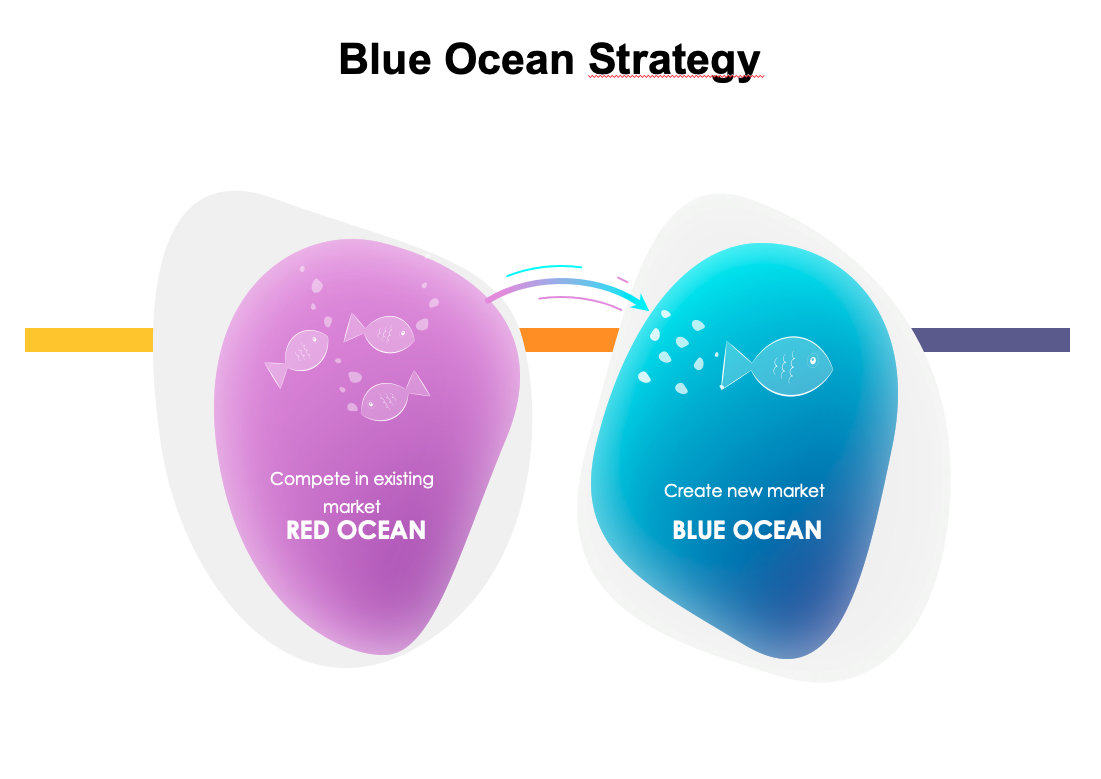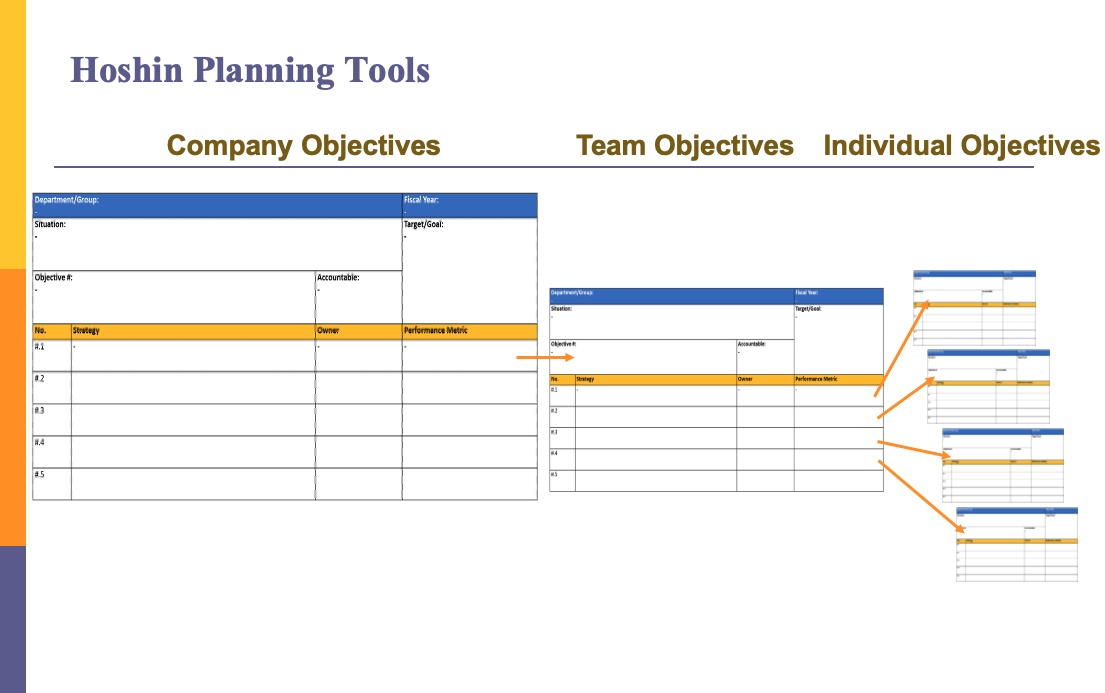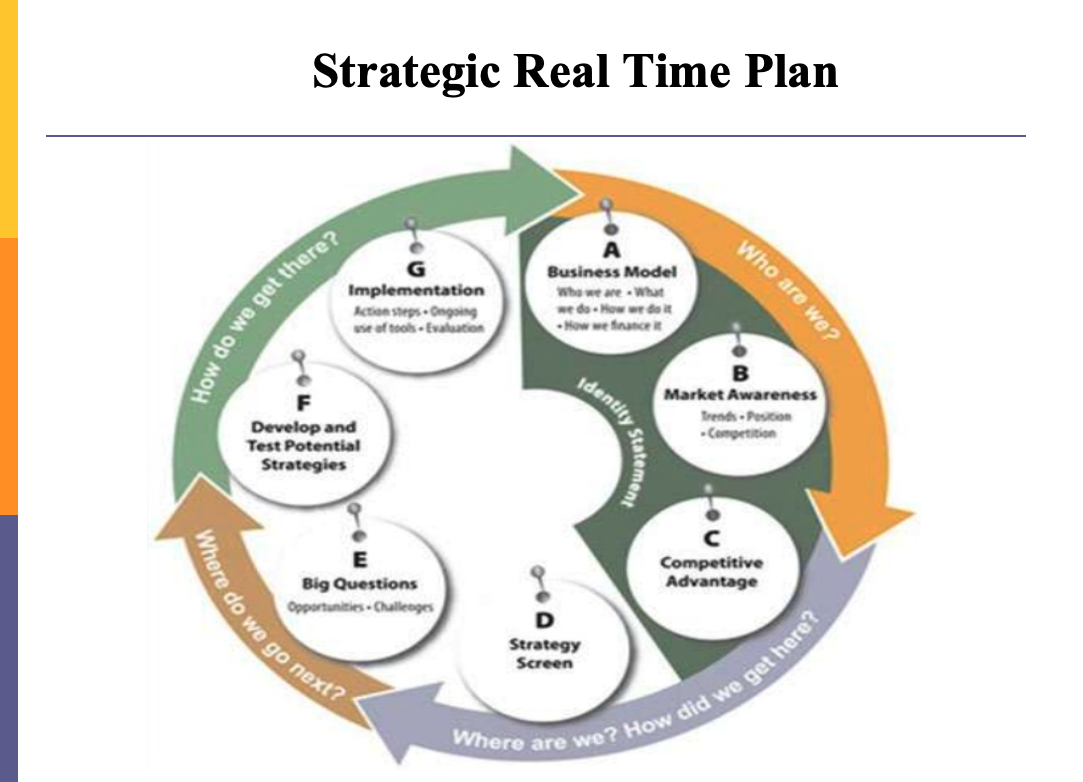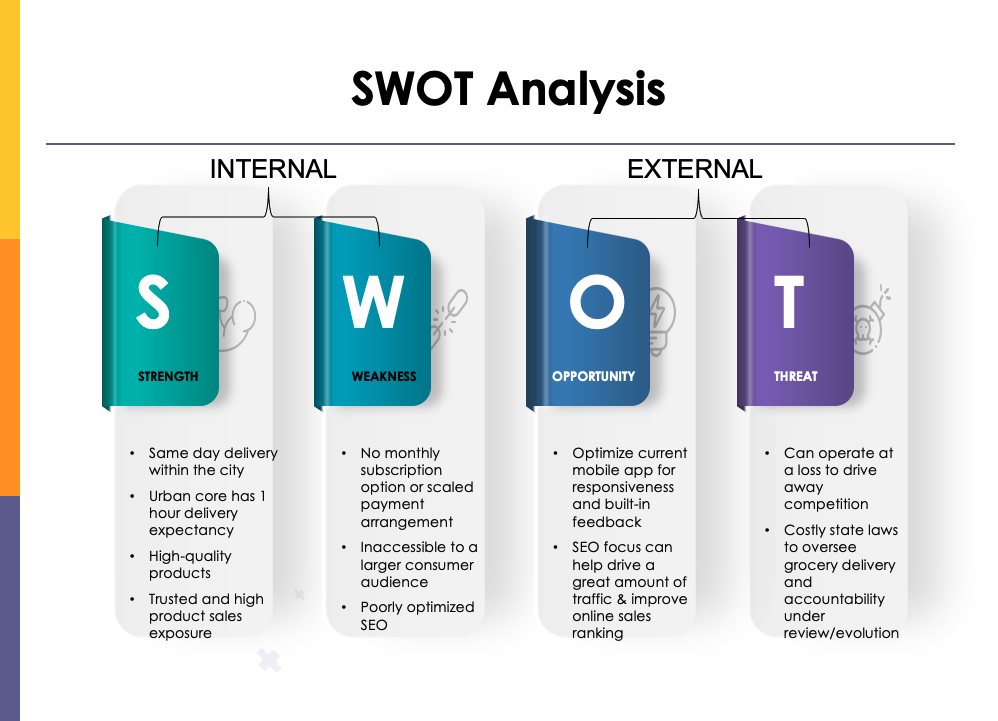Strategic Planning & Decision Making
- Home
- Strategic Planning & Decision Making

The BSC was designed to measure the performance of an organization in four perspectives, namely financial, customer, internal business process, and learning and growth.
- The customer perspective – this refers to customer concerns about time, quality, performance, service and cost.
- The internal business process perspective – this refers to those business processes that have the greatest impact on customer satisfaction.
- The innovation and learning perspective – this refers to innovation, as well as improvements to existing products and processes.
- The financial perspective – this refers to the extent to which the company strategy contributes to profitability, growth and shareholder value.
For each perspective, the objectives, measures, targets and initiatives are defined as relates to the vision, mission and strategy to enable performance monitoring. This model is used extensively in business and industry, government, and non-profit organizations worldwide to align business activities with the vision and strategy of the organization; to improve internal and external communications; and to monitor organization performance against strategic goals. (www..)

Red oceans represent all the industries in existence today – the known market space. In the red oceans, industry boundaries are defined and accepted, and the competitive rules of the game are known. Here companies try to outperform their rivals to grab a greater share of product or service demand. As the market space gets crowded, prospects for profits and growth are reduced. Products become commodities or niche, and cutthroat competition turns the ocean bloody; hence, the term "red oceans". Blue oceans, in contrast, denote all the industries not in existence today – the unknown market space, untainted by competition. In blue oceans, demand is created rather than fought over.
There is ample opportunity for growth that is both profitable and rapid. In blue oceans, competition is irrelevant because the rules of the game are waiting to be set. Blue ocean is an analogy to describe the wider, deeper potential of market space that is not yet explored. The cornerstone of blue ocean strategy is "value innovation", a concept originally outlined in Kim & Mauborgne's 1997 article "Value Innovation - The Strategic Logic of High Growth". Value innovation is the simultaneous pursuit of differentiation and low cost, creating value for both the buyer, the company, and its employees, thereby opening up new and uncontested market space. The aim of value innovation, as articulated in the article, is not to compete, but to make the competition irrelevant by changing the playing field of strategy. The strategic move must raise and create value for the market, while simultaneously reducing or eliminating features or services that are less valued by the current or future market. The Four Actions Framework is used to help create value innovation and break the value-cost trade-off. Value innovation challenges Michael Porter's idea that successful businesses are either low-cost providers or niche-players. Instead, blue ocean strategy proposes finding value that crosses conventional market segmentation and offering value and lower cost. Educator Charles W. L. Hill proposed a similar idea in 1988 and claimed that Porter's model was flawed because differentiation can be a means for firms to achieve low cost. He proposed that a combination of differentiation and low cost might be necessary for firms to achieve a sustainable competitive advantage. (www.Wikipedia.com)

Gap Analysis can be understood as a strategic tool used for analyzing the gap between the target and anticipated results, by assessing the extent of the task and the ways, in which gap might be bridged. It involves making a comparison of the present performance level of the entity or business unit with that of standard established previously. In management literature, gap analysis involves the comparison of actual performance with potential or desired performance. If an organization does not make the best use of current resources, or forgoes investment in capital or technology, it may produce or perform below an idealized potential. This concept is similar to an economy's production being below the production possibilities frontier.
Gap analysis identifies gaps between the optimized allocation and integration of the inputs (resources), and the current allocation-level. This reveals areas that can be improved. Gap analysis involves determining, documenting and improving the difference between business requirements and current capabilities. Gap analysis naturally flows from benchmarking and from other assessments. Once the general expectation of performance in an industry/environment is understood, it is possible to compare that expectation with the company's current level of performance. This comparison becomes the gap analysis. Such analysis can also be performed at the strategic or at the operational level of an organization.
- Identify the area to be analyzed and identify the goals to be accomplished. ...
- Establish the ideal future state. ...','Analyze the current state. ...
- Analyze the current state. ...
- Compare the current state with the ideal state. ...
- Describe the gap and quantify the difference.

The Hoshin Planning System is a seven-step procedure that outlines how to implement business strategy. More specifically, this system aims to align the goals that the organization is trying to achieve with its strategy and the resources that are available within the company. The seven steps in the Hoshin Planning System should be followed in this order:
Step 1: Establish Organizational Vision. Before creating a new vision statement, it is important to assess the current state of the organization to determine how far away it is from what it is envisioned to be. This assessment involves examining current policies, organizational hierarchies, current long-term goals, and older mission and vision statements. Step 2: Develop Breakthrough Objectives. A breakthrough objective is the large-scale change that the organization wants to make that should take roughly three to five years to implement. Identifying these larger changes involves exploring new areas in the industry, new clientele, etc. Step 3: Develop Annual Objectives. This stage involves breaking the larger goals into smaller goals for the year. Step 4: Deploy Annual Objectives. After identifying the yearly goals, break them down into actionable items for each department or individual in the company. In this way, every level of the organization is collectively working toward achieving the breakthrough objectives. Breaking it down in this way helps to align and integrate every level of the company. Additionally, progress toward smaller goals should be monitored and completion dates should be cataloged to record progress towards the breakthrough objective. Step 5: Implement Annual Objectives. At the end of each year, the smaller tasks that are needed to implement the annual improvements should be completed. Step 6: Conduct Monthly Reviews. Keeping detailed records of smaller task completion will help to determine how successful the organization is in meeting its larger goals and will also help to identify any changes to current tasks or new projects that need to be added to the strategy. Having a meeting every month helps to keep everyone accountable for getting their work done efficiently and on time. Step 7: Conduct Annual Reviews. Meetings should also be held at the end of the year to determine how far off target the organization is from reaching its breakthrough objectives. Keeping track of this progress will help to determine what should be done differently the following year.
.png)
The acronym OKR stands for ‘Objectives and Key Results.’ It is a goal setting framework that has been around since 1970s. Popularized by John Doerr, one of the most successful venture capitalists, OKR sets the basis for defining your organizational objectives over a specified period of time. OKRs are frequently set and evaluated continuously during the project lifecycle to make sure everything gets done on time. They also act as future references to monitor how well you executed your projects. So, the basic formula behind an OKR is to set an objective, and 3 to 5 key results against it. These key results are concrete, measurable actions which lead towards achievement of objectives. A major chunk of OKR is to make sure that everyone knows what they need to do, or what’s expected of them. (https://medium.com/ntask/how-to-write-objectives-and-key-results-best-okr-examples-of-2019)

The PESTLE analysis is a tool used as situational analysis for business/strategy evaluation purposes. This tool is one of the most frequently applied models in the evaluation of the highly dynamic external business/strategic environment. A growing number of studies applied this analytical tool in different sustainable projects, including the evaluation of external factors affecting management decisions for coastal zone and freshwater resources, development of sustainable buildings,sustainable energy solutions,and transportation and so on ….
The basic PEST analysis includes four factors: Political factors relate to how the government intervenes in the economy. Specifically, political factors have areas including tax policy, labour law, environmental law, trade restrictions, tariffs, and political stability. Political factors may also include goods and services which the government aims to provide or be provided (merit goods) and those that the government does not want to be provided (demerit goods or merit bads). Furthermore, governments have a high impact on the health, education, and infrastructure of a nation. Economic factors include economic growth, exchange rates, inflation rate, and interest rates. These factors can drastically effect how a business operates. For example, interest rates affect a firm's cost of capital and therefore to what extent a business grows and expands. Social factors include the cultural aspects and health consciousness, population growth rate, age distribution, career attitudes and emphasis on safety. High trends in social factors affect the demand for a company's products and how that company operates. For example, the ageing population may imply a smaller and less-willing workforce (thus increasing the cost of labour). Furthermore, companies may change various management strategies to adapt to social trends caused from this (such as recruiting older workers). Technological factors include technological aspects like R&D activity, automation, technology incentives and the rate of technological change. These can determine barriers to entry, minimum efficient production level and influence the outsourcing decisions. Furthermore, technological shifts would affect costs, quality, and lead to innovation. Expanding the analysis to PESTLE or PESTEL adds: Legal factors include discrimination law, consumer law, antitrust law, employment law, and health and safety law. These factors can affect how a company operates, its costs, and the demand for its products. Environmental factors include ecological and environmental aspects such as weather, climate, and climate change, which may especially affect industries such as tourism, farming, and insurance. Furthermore, growing awareness of the potential impacts of climate change is affecting how companies operate and the products they offer, both creating new markets and diminishing or destroying existing ones. (www.Wikipedia.com)


Real Time Strategic Plan Process Tools
- Organizational Identity statement
- Strategy Screen
- Big Questions
- One Page Strategic Plan
- Board process Commitment to Planning as Core Board Function
Real-time Strategic Planning is similar to the organic model of planning. This model is particularly suited for those who believe that the rapidly changing and dynamic nature of organizations make long-term and detailed planning irrelevant. These experts might assert that planning for an organization should be done continuously, or in real time. The real-time planning model is best suited to organizations with very rapidly changing external environments. The steps involved in this model are:
(a) Define or update your mission, vision and values; (b) Assign planners to research the external environment and, as a result, suggest a list of opportunities and threats facing the organization; (c) Present the list to the Board and other members of the organization for strategic thinking and discussions; (d) Soon after (perhaps during the next month) assign planners to evaluate the internal workings of the organization and, as a result, suggest a list of strengths and weaknesses in the organization; (e) Present this list to the Board and other members of the organization for strategic thinking and discussions, perhaps using a SWOT analysis to analyse all four elements; (f) Repeat steps (b) to (e) regularly, for example, every six months or year, and document the results in a strategic plan. https://www.apiahf.org/resource/webinar-introduction-to-real-time-strategic-planning/

A strategy map is a diagram that is used to document the primary strategic goals being pursued by an organization or management team. It is an element of the documentation associated with the Balanced Scorecard, and in particular is characteristic of the second generation of Balanced Scorecard designs that first appeared during the mid-1990s. The strategy map idea featured in several books and articles during the late 1990s by Robert S. Kaplan and David P. Norton. Their original book in 1996, "The Balanced Scorecard, Translating strategy into action", contained diagrams which are later called strategy maps, but at this time they did not refer to them as such. Kaplan & Norton's second book, The Strategy Focused Organization, explicitly refers to strategy maps and includes a chapter on how to build them. At this time, they said that "the relationship between the drivers and the desired outcomes constitute the hypotheses that define the strategy". Their Third book, Strategy Maps, goes into further detail about how to describe and visualise the strategy using strategy maps.
The Kaplan and Norton approach to strategy maps has: An underlying framework of horizontal perspectives arranged in a cause and effect relationship, typically Financial, Customer, Process and Learning & Growth Objectives within those perspectives. Each objective as text appearing within a shape (usually an oval or rectangle). Relatively few objectives (usually fewer than 20) Vertical sets of linked objectives that span the perspectives. These are called strategic themes. Clear cause-and-effect relationships between these objectives, across the perspectives. www.wikipedia.com

SWOT analysis (or SWOT matrix) is a strategic planning technique used to help a person or organization identify strengths, weaknesses, opportunities, and threats related to business competition or project planning. This technique, which operates by peeling back layers of the company, is designed for use in the preliminary stages of decision-making processes and can be used as a tool for evaluation of the strategic position of organizations of many kinds (for-profit enterprises, local and national governments, NGOs, etc.) It is intended to specify the objectives of the business venture or project and identify the internal and external factors that are favorable and unfavorable to achieving those objectives. Users of a SWOT analysis often ask and answer questions to generate meaningful information for each category to make the tool useful and identify their competitive advantage. SWOT has been described as the tried-and-true tool of strategic analysis, but has also been criticized for its limitations .

VRIO is a business analysis framework that forms part of a firm's larger strategic scheme. The basic strategic process that any firm begins with a vision statement, and continues on through objectives, internal & external analysis, strategic choices (both business-level and corporate-level), and strategic implementation. The firm will hope that this process results in a competitive advantage in the marketplace they operate in. VRIO falls into the internal analysis step of these procedures, but is used as a framework in evaluating just about all resources and capabilities of a firm, regardless of what phase of the strategic model it falls under. VRIO is an initialism for the four question framework asked about a resource or capability to determine its competitive potential: the question of Value, the question of Rarity, the question of Imitability (Ease/Difficulty to Imitate), and the question of Organization (ability to exploit the resource or capability).
The Question of Value: "Is the firm able to exploit an opportunity or neutralize an external threat with the resource/capability?" The Question of Rarity: "Is control of the resource/capability in the hands of a relative few?" The Question of Imitability: "Is it difficult to imitate, and will there be significant cost disadvantage to a firm trying to obtain, develop, or duplicate the resource/capability?" The Question of Organization: "Is the firm organized, ready, and able to exploit the resource/capability?" "Is the firm organized to capture value?« www.Wikipedia.com

WHAT IS APART?
APART (Artificial Intelligence Powered Advanced Red Teaming) is a genuine red teaming method originally designed by a diverse group of professionals from a wide spectrum of expertise. APART, supported by cutting edge technologies -primarily the human-augmented artificial intelligence-, enables planners, decision makers and managers to assess their plans, assumptions and preparedness for the future as well as their current status and performance in multiple scenarios within a plausibility universe through a realistic simulation of threats, adversaries, environment.
APART offers both active and passive red teaming services at all levels (strategic, operational, tactical) for a wide range of enterprises
- NGOs
- Corporations
- Academia
- Government Institutions
Readiness for everything possible is crying for the moon; our promise is preparedness for everything plausible beyond the horizon.
The APART team consists of two types of staffing: in-house and interim. In-house staff are distinguished professionals from a broad spectrum of background and expertise: scholars, IT professionals, AI/ML experts, business professionals and former military officers deeply experienced in homeland security, counter-terrorism, wargaming, strategic management & planning. Where necessary, additional staff is hired ad interim on the basis of case-specific requirements, such as a biochemist, a band of white hat hackers or a cryptologist.
WHO NEEDS APART?
From statistically possible to smartly plausible
We are fearless as outsiders, responsible as insiders!
- 01
Corporations
Are you ready for what is to come? Yes? So, you have multiple contingency plans, how nice! Have you tested them? Have you assessed the plausibility of your scenarios, verified the validity of your courses of action, decently simulated all threats including black swans (Oh, yes, there ARE black swans)? You did these with your own people? All insiders? Individuals who are inherently on your side, who think within your mind frame? Alright. YOU need APART!
- 02
Government Institutions
Imagine a bunch of well-educated smart guys producing reports and devising policy advice for future security environment. One tiny problem: They are probably from similar demographics & same nationality, they have similar education, similar experience, similar worldviews and worst of all, they probably groupthink. Oh no, even worst, they groupthink within hierarchical roles. Is this you? YOU need APART!
- 03
Academia
Universities around the world offer similar curricula on Homeland Security, Political Science and International Relations, Public Administration, etc. Common thread to all this is that they rely on theory rather than practice. Millions of future HS professionals, public administrators, politicians and decision-makers read the same papers, adopt the same assumptions, fear the same threats and think within the same box. What if a Crisis Operations Management lecture was conducted on the basis of scenario designed by a group of professionals who have relevant expertise that allows them to think, plan and act like a terrorist? What if it was not just one type of terrorist but a diverse range of global, regional or even local armed groups? What if, as chance would have it, these red teamers have individually interviewed hundreds of terrorists in person so that they can’t help laughing at how theory describes these individuals? Does raising down-to-earth HS professionals in a scenario-based learning environment sound interesting to you? Then, YOU need APART!
- 04
NGOs and INGOs
This is probably the most fun. NGOs need to prepare for the future which will mostly be shaped or at least shifted by disruptive, noncompliant, unpredictable, immoral, ambiguous and/or irrational actors along with an environment influenced by various and variable factors. NGOs are not profit-oriented and they usually run on a limited budget. Staff are probably the most decent and benevolent men and women on earth with the cleanest records available. If you are that NGO who needs a realistic, smart and merciless outsider look on your plans and projections, YOU need APART!
Partners





